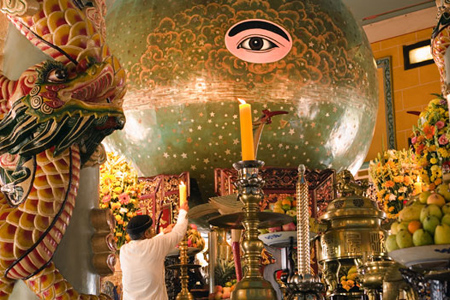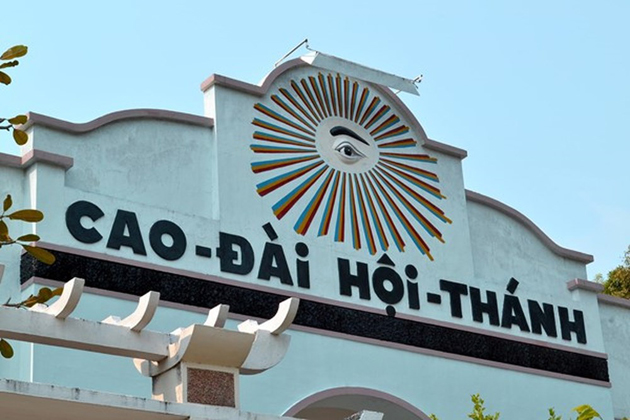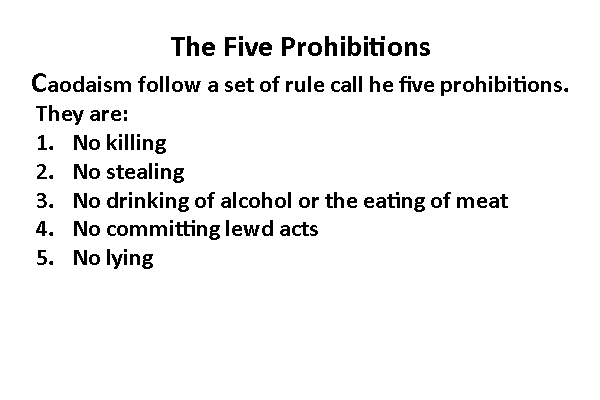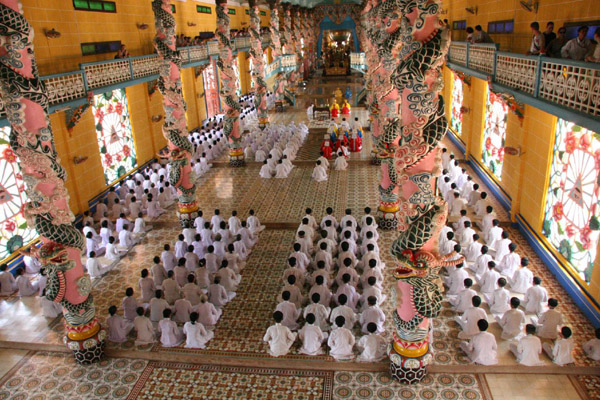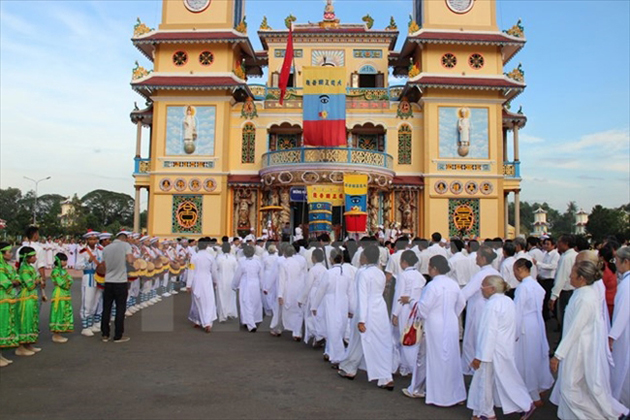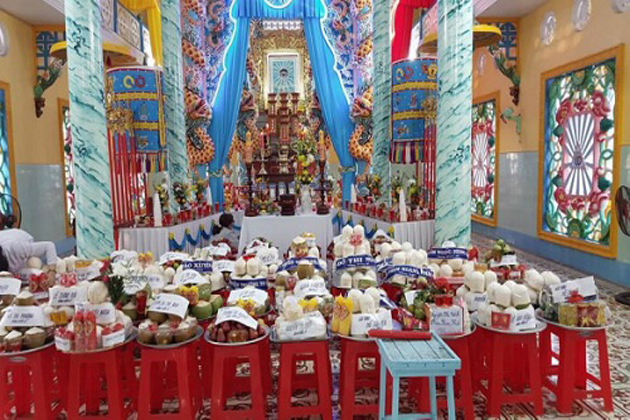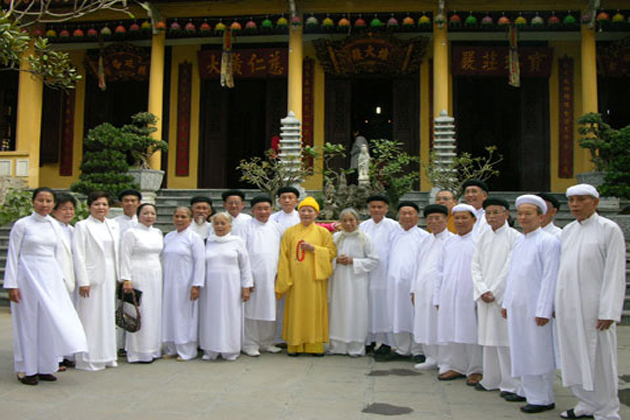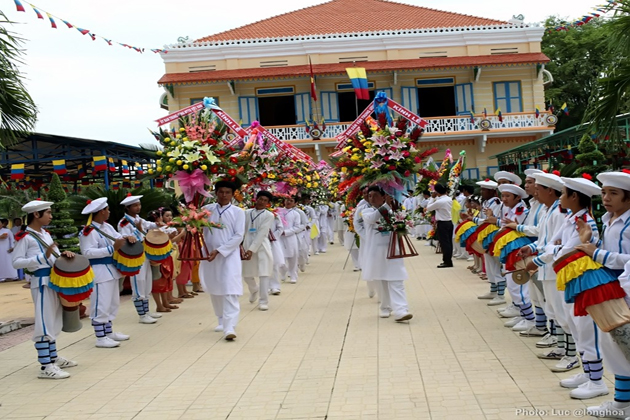Caodaism’s ritual rules were written in many ancient books such as Dai Thua Chan Giao (Great Esoteric Vehicle), Ngoc De Chan Truyen (Jade Emperor’s Orthodox Dogmas), Phap Chanh Truyen (Religious Constitution), Tan Luat (The New Canonical Codes), and Thanh Ngon Hop Tuyen (Collection of Selected Divine Messages). Some Caodaist sects such as Tay Ninh Caodaism, Tien Thien Caodaism, Ban Chinh Dao Caodaism and Minh Chon Caodaism are mainly based on Tan Luat, Phap Chanh Chuyen, and Thanh Ngon Hop Tuyen. Meanwhile, others including Thuong De Caodaism, Bach Y Caodaism, and Chieu Minh Caodaism have the basis of Dai Thua Chan Giao and Ngoc De Chan Truyen. Accordingly, there are different rules of rituals, worship, prayers, dressing styles, and religious practices showing that Caodaism is one of the orthodox and long-established religions in Vietnam and the world.
The Five Prohibitions of Caodaism - Ngu Cam Gioi
It includes No Killing (it is forbidden to kill living beings); No Stealing (it is forbidden to rob or trick other belongings); No Indulging in Alcohol (it is forbidden to abuse the drinking of alcohol or the eating of meat since it may lead to sinful deeds); No Committing Lewd Acts (it is forbidden to commit adultery, fall into debauchery or encourage others to act immorally); and No Lying (it is forbidden to tell lies, use bad words or renege on a promise).
The Four Great Commandments of Caodaism - Tu Dai Dieu Quy
The Four Great Commandments includes the following precepts:
First, one should obey the teachings given by the superiors, listen openly to the words and advice given by an inferior, treat others civilly, and sincerely admit and repent one’s mistakes.
Second, one should not flaunt talents or qualities in pride and haughtiness, should be humble and efface oneself in the service of others, should help and guide others into God’s path, should not be vengeful, and should not hinder virtuous and wise people.
Third, one should be accurate in money matters, should not borrow without paying back, should not be impolite or discourteous to superiors, and should be civil and courteous when teaching inferiors.
Last, one should be sincere and consistent in both the presence and absence of others; should not be respectful in the presence of others and then insult condemn, or offend them in their absence; should not remain indifferent without trying to reconcile co-believers who are in conflict; and should not use authority to repress the talents or abilities of others.
Caodaism’s Other Rules for Followers
In general, one should incessantly improve these four virtues: moderation, respect, modesty, and concession. In addition, Caodaists must also observe either a time-limited vegetarian diet (six or ten days per month) or a permanent one. Besides, Caodaism has its own rules for the establishment of parishes, construction of temples, and organization of marriages and funerals. A Caodaist parish must have at least 500 followers. Anyone who wishes to follow the religion must be guided and guaranteed by at least two Caodaist followers.
Confucian Moral Standards of Caodaism
Caodaism gives prominence to educating its followers about morality according to Confucian moral standards. They include many rules existed Vietnamese culture dictionary such as the Three Social Ties or Tam Cuong (the relationships between king and subject, father and child, and husband and wife); the Five Constant Virtues or Ngu Thuong (kindness, decorum, uprightness, wisdom, and faithfulness); the requirements of an ideal woman consisting of Three Obedienics or Tam Tong (responsibilities of daughter for her parents, wife for her husband, and widow for her son) and the Four Virtues or Tu Duc (merit, appearance, speech, and behavior).
Types of Caodaism’s Followers
There are two categories of followers in Caodaism: the lower and the higher. The lower category includes ordinary adherents who will follow the aforementioned rules to the best of their abilities. The higher category consists mainly of dignitaries, from the rank of Giao Huu (Priest) upwards, who are supposed to follow these rules strictly. For example, they have to leave their home to become Caodaists, practice a permanent vegetarian diet, and devote their whole lives to the faith. Although they are not required, they are encouraged to leave their hair and beards untrimmed.
The Rituals of Caodaism
Offerings in Caodaism
Caodaism’s rituals are very complicated, which is mainly due to the facts they are designed to reflect the synthesis of many religions. For example, the offerings in Caodaism include five incense sticks representing the five stages in the life of a Buddhist follower (purification, meditation, wisdom, universal knowledge and liberation). According to the book Dai Thua Chan Giao, these five incense sticks represent the five basic elements (metal, wood, water, fire, and earth). The offerings also include wine, tea, and flowers presenting the body, the breath, and the mind respectively—the Three Treasures in Taoism and the basis of life in the Taoist viewpoint.
When Caodaist followers make offerings to God, they must move their feet in the shape of the Chinese character - xin (heart), according to Confucianism. They also move their right hand from the forehead to the chest, left shoulder and right shoulder, making the sign of the cross. However, the gesture represents the Three Refuges (Buddha, Dharma, and Sangha) in Buddhism, not the Trinity (Father, Son, and Holy Spirit) in Catholicism.
Caodaism’s Traditional Costumes
Caodaist followers’ clothes in white while high-ranking dignitaries wear colored robes according to their sections: yellow for Thai (Buddhist section), red for Thuong (Taoist section) and azure for Ngoc (Confucian section). Whatever colors they are in, their robes are made sophisticatedly, like those of feudal mandarins in the East.
Caodaism’s Prayer-Books
The books for praying of Caodaism include Kinh Cung Tu Thoi (Daily Prayers), Kinh Quan Hon Tang (Prayers at Marriages and Funerals), Kinh Thien Dao (Prayers of the Heavenly Way), and Kinh The Dao (Prayers of the Earthly Way). They are all written in the forms of verses and Southern folk songs.
Caodaism’s Daily Rituals and Festivals
Daily rituals include four services held in the early morning (at around 5 am), midday (at 12 am), in the late afternoon (at around 5 pm), and at night (at 12 pm). There are two ceremonies held every month called SOC and Vong, which take place on the first and fifteenth days of the lunar calendar respectively. Annual festivals include the Anniversary of the Jade Emperor’s Birthday (January 9), the Thuong Nguyen Festival (January 15), the Anniversary of Lao Tzu’s Birthday (February 2), the Anniversary of Sakyamuni Buddha’s Birthday (April 8), the Trung Nguyen Festival (July 15), the Birthday Anniversary of Bodhisattva of Mercy (August 15), and the Ha Nguyen Festival (October 15). All are held according to the lunar calendar and play an important part in Vietnamese customs. Besides, each sect has its own anniversaries to commemorate its establishment as well as its leader’s birthday and death.
The aforementioned tenets, rites and rituals led to the misunderstanding that Caodaism was a mixed religion, that “Caodaism is just a simple addition of the elements available in existing religions,” or that “Caodaism is an old thing that has been repainted by its believers; all the old things reappear under a new name which looks both strange and familiar.”
However, it should be admitted that Caodaism is close to and suitable for the level of awareness of the majority of the people in the South in certain socio-economic contexts. Moreover, with its rules, rituals, and practices that inherit and preserve the traditional traits of the Southern culture, Caodaism has rapidly taken root in daily life, and become the customs, practices, and lifestyle of the majority of its believers.

